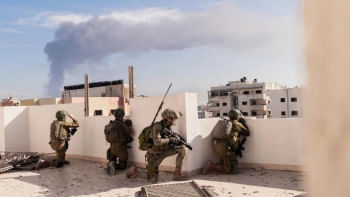Photography exhibition ‘Bangladesh 1971: Mourning and Morning’ kicks off

The Liberation War Museum and Alliance Française de Dhaka have jointly organised the solo photography exhibition, "Bangladesh 1971: Mourning and Morning" by Marc Riboud. The exhibition's opening ceremony was held at the Liberation War Museum on October 16.
Dr A K Abdul Momen MP, Foreign Minister of Bangladesh, graced the occasion as the chief guest. HE Jean-Marin Schuh, Ambassador of France to Bangladesh, attended the event as the guest of honour.

Supported by L'association Les amis de Marc Riboud and Musée Guimet, it is a unique exhibition of never-before-seen photographs taken during the Liberation War of Bangladesh. Fifty photographs are on display for the exhibition.

One of the first generation of Magnum photographers, French veteran photographer Marc Riboud was born in Saint-Genis-Laval, near Lyon, in 1923. He shot his first photographs at the Exposition Universelle in Paris in 1937, using a tiny Vest Pocket Kodak given to him by his father for his 14th birthday. In 1944, he joined the Vercors resistance. From 1945 to 1948, he studied Engineering at Lyon's Ecole Centrale and began working. Three years later, he chose to pursue a career as a photographer.
His photo of a painter atop the Eiffel Tower was published in "Life" magazine in 1953. This was his first published work. Afterwards, he joined the Magnum Photos agency after being invited by Henri Cartier-Bresson and Robert Capa.

He travelled by road from the Middle East and Afghanistan to India in 1955, where he remained for a year. In 1957, he travelled from Kolkata to Beijing for the first of many extended stays. In Japan, he discovered the inspiration for what would become his debut book, "Women of Japan", after a long road journey across the Far East and the Middle East.
After a three-month sojourn in the Soviet Union, he returned to cover the independence movements in Algeria and Sub-Saharan Africa in 1960. Between 1968 and 1976, he was one of the few photographers permitted to shoot in both South and North Vietnam. His picture of a young woman holding a flower, taken in front of the Pentagon during a protest against the Vietnam War, became an international symbol of peace.
Bangladesh's independence struggle piqued his attention, and he arrived in Kolkata in late November 1971. He journeyed inside to refugee camps and liberated zones. His expedition began at Sherpur, and after crossing the mighty Brahmaputra River, he witnessed the decisive battle of Jamalpur, which he extensively documented.

The majority of these are still unpublished to this day. When the all-out Indo-Pakistan war broke out on 3 December, he entered Bangladesh with an advancing Indian army backed up by Bangladeshi freedom fighters. He was one of the first photographers to enter Dhaka and capture the city's liberation with his camera.
In the 1980s and 1990s, he frequently returned to the East and the Far East, particularly to Angkor and Huang Shan, but he also saw China's fast and significant transformation, a nation he had been looking at for more than thirty years.
Marc Riboud donated 192 original prints produced between 1953 and 1977 to the National Museum of Modern Art (Centre Georges Pompidou) in Paris in 2011. His art has received many prestigious honours and has been shown in museums and galleries in Paris, New York, Shanghai, and Tokyo, among other places.

Marc Riboud passed away in Paris in 2016 at the age of 93. The majority of his archives were given to the National Museum of Asian Arts - Guimet in Paris.
After the inaugural ceremony, the exhibition will be open to all till November 16. Visiting hours are Monday through Thursday from 10 am to 5 pm (closed on Sunday).
"Bangladesh 1971: Mourning and Morning" is jointly curated by Lorène Durret and Mofidul Hoque. The second phase of the exhibition will take place at Alliance Française de Dhaka in January 2022.

 For all latest news, follow The Daily Star's Google News channel.
For all latest news, follow The Daily Star's Google News channel. 



Comments